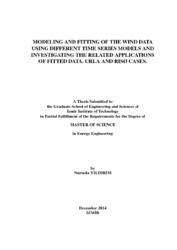Please use this identifier to cite or link to this item:
https://hdl.handle.net/11147/4287| Title: | Modelling and Fitting of the Wind Data Using Different Time Series Models and Investigating the Relared Applications of Fitted Data. Urla and Risø Cases | Other Titles: | Rüzgar Verilerinin Çeşitli Zaman Serisi Yöntemleriyle Modellenmesi, Üretilen Verinin Uygulama Alanlarının İncelenmesi. Urla ve Risø Örnekleri. | Authors: | Yıldırım, Nurseda | Advisors: | Duran, Hasan Engin Bingöl, Ferhat |
Keywords: | Wind Wind energy Wind energy forecasting VAR SARIMA WAsP |
Publisher: | Izmir Institute of Technology | Source: | Yıldırım, N. (2014). Modelling and fitting of the wind data using different time series models and investigating the relared applications of fitted data. Urla and RisØ cases. Unpublished master's thesis, İzmir Institute of Technology, İzmir, Turkey | Abstract: | This thesis is prepared as an outcome of Energy Engineering Master of Science program at IZTECH. Main purpose of this study is to investigate the possible ways of estimating the evolution of wind speed in Turkey, which is useful in predicting the wind power generation. Wind Energy has recently been recognized as one of the most promising renewable energy sources in the world. Despite its high potential, one major problem is that it is an intermittent energy source which follows, in general, statistically a quite noisy evolution with large variability and difficulty in forecasting. Standard time series models have been employed to forecast the wind speed in the literature (such as ARIMA, ARMA). The majority of these, however, are based on a univariate modelling. This is likely to create a significant loss in forecast accuracy as the important dynamics of wind such as ambient temperature, absolute pressure, wind direction and humidity are ignored. So, aim of the present study is to incorporate these factors in a multivariate VAR setting and estimate the wind speed in 4 different locations around Urla City (nearby Izmir-Turkey) by employing hourly data between June-2000 and October-2001. To provide a benchmark, I also compare estimations from VAR with the predictions from ARIMA and SARIMA models. The results indicate two important conclusions. First, it has been shown that all models provide an accurate estimate of wind speed. Second, multivariate VAR and SARIMA is clearly shown to outperform the ARIMA model by improving the wind speed predictions and producing less forecast errors. Thus, these models are demonstrated to be helpful in estimating the wind power generation as well. | Description: | Thesis (Master)--Izmir Institute of Technology, Energy Engineering, Izmir, 2014 Includes bibliographical references (leaves: 83-85) Text in English; Abstract: Turkish and English xiii, 121 leaves |
URI: | http://hdl.handle.net/11147/4287 |
| Appears in Collections: | Master Degree / Yüksek Lisans Tezleri |
Files in This Item:
| File | Description | Size | Format | |
|---|---|---|---|---|
| T001310.pdf | MasterThesis | 15.36 MB | Adobe PDF |  View/Open |
CORE Recommender
Page view(s)
434
checked on Mar 10, 2025
Download(s)
246
checked on Mar 10, 2025
Google ScholarTM
Check
Items in GCRIS Repository are protected by copyright, with all rights reserved, unless otherwise indicated.